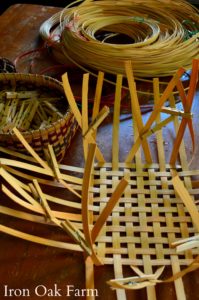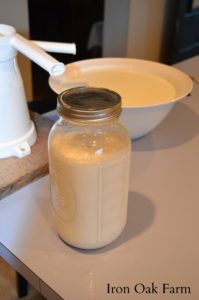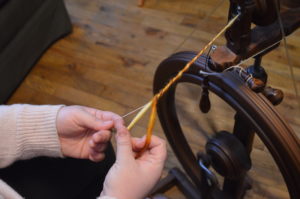How to Use Skill-Teaching as an Income on the Homestead
 Teaching classes on your homestead can be a lot of fun and quite rewarding. Over the years, my husband and I have taught many classes at our farm; everything from how to milk a goat, blacksmithing, basket weaving and yarn spinning.
Teaching classes on your homestead can be a lot of fun and quite rewarding. Over the years, my husband and I have taught many classes at our farm; everything from how to milk a goat, blacksmithing, basket weaving and yarn spinning.
Classes can serve:
– As an additional income to a product or service you sell
– They can serve as a loophole income to otherwise difficult or highly regulated product.
– And they can also serve as a way for people to become interested in a supply product you sell.
Additional Income– Sometimes, to make a homesteading venture completely sustainable you have to do more than just sell a product. Many times, you break even at best. For example, many people find that it can be difficult to make money by raising chickens for eggs. Many times the feed costs off set any profit you might make by egg sales. However, you could offer a class on raising chickens and this would bring in additional income.
Off Season– Teaching classes is an additional way to bring income into your homestead on off seasons. For example, we freeze goat milk throughout the spring and summer so I can make soap throughout the winter. A winter soap making class would be a great addition to our farm and something I plan on tackling in the future.
This also works for our fiber goats. In the summertime I’m too busy running our farm to teach spinning. But in the winter, when the garden and lavender field are resting, it’s the perfect time to take on new students and teach them a yarn class.
 Loophole Income– Many times agriculture/food laws can be confusing and restrictive. For example, Michigan, our home state, has very strict diary laws. For us to sell milk from our goats we would have to spend a lot of money on certifications, specialized dairy equipment etc. We’re simply not interested in investing that much time, money and effort into the dairy aspect of our farm. However, there are no regulations on teaching a class about dairy animals.
Loophole Income– Many times agriculture/food laws can be confusing and restrictive. For example, Michigan, our home state, has very strict diary laws. For us to sell milk from our goats we would have to spend a lot of money on certifications, specialized dairy equipment etc. We’re simply not interested in investing that much time, money and effort into the dairy aspect of our farm. However, there are no regulations on teaching a class about dairy animals.
We’ve taught our Afternoon with a Goat class for several years, and had great success!
Increase Interest in Supply Products – If you sell a supply product, teaching a class is a great way to create new buyers. For example, I sell roving and fiber from our goats. I also teach people how to spin. These new spinners will be looking for roving and fiber to further their practice. I offer returning students a discount on all fiber purchases as an incentive to buy from me.
Yarn stores do this all the time. They teach knitting and crocheting classes and sell their yarn to the students. It creates an exponential gain!
Teaching a Class
Teach what you’re good at and what you enjoy. What activities do you love? Have people seen your work and exclaimed “I wish I could do that.”? Then there might be an opportunity for a class.
Preparing for Class
-Be transparent about exactly what your students will learn. It’s also important to be transparent about your experience level. I find that itemizing the class activities is always appreciated.
-Collect deposits to hold class spaces. You will be glad you did, I promise! We learned the hard way. For our first dairy goat class we announced the time and date of the class on social media. A ton of people said they would attend. I even turned people away because the list was getting too large. Zach and I spent a week preparing, gathering supplies etc. only to find on the day of, a fraction of the people who said they were coming actually showed up. Collecting payment or deposit beforehand holds people accountable to the date.
You can offer a Pay Pal payment or have them send a check. We don’t cash any deposit checks until after the class is taught.
-Do a dry run. Invite friends or family over and run through your class with them before you go public. You might think you have the whole class down pat in your head, but you might be surprised what might come up as you actually teach. A dry run is always helpful.
-Have things organized and in place. Students have paid money to get the most from your class. They don’t want to stand around waiting while you look for something, or prepare materials.
Waivers- It’s never a bad idea to have people who visit your farm sign a waver. Farms can be dangerous places, especially with animals, heavy equipment etc. If there’s an element of danger…no matter how small, consider writing up a waiver and have your students sign before participating. We do this with ALL our animal related classes.
What to Charge
This is always a difficult thing to figure out. Below are some tips to help you come up with a fair figure.
-Do a online search for classes similar to what you are offering and price compare.
-Are you certified? Do you have lengthy experience in a particular skill? Advertise that and be confident in reflecting your experience in the price.
-Is it a 1 on 1 course, or more of a group activity? 1 on 1 demands your full attention so students should expect to pay more for your time.
 -Material costs also need to be considered. You need to choose if you are going to upcharge your students for materials or include them at purchase cost. This can vary depending on the nature of the item. For example when I teach yarn spinning I use our own roving/wool as a material. I include the retail price into the total price of the class but at a discounted level. However, when I taught a basket weaving class in the past, I only charged my students cost for the weaving material.
-Material costs also need to be considered. You need to choose if you are going to upcharge your students for materials or include them at purchase cost. This can vary depending on the nature of the item. For example when I teach yarn spinning I use our own roving/wool as a material. I include the retail price into the total price of the class but at a discounted level. However, when I taught a basket weaving class in the past, I only charged my students cost for the weaving material.
-Another consideration is if the students are going to leave with a collection of knowledge or a tangible product. Both are valuable, so don’t sell yourself short. But in my experience, people are more willing to pay extra if they get to go home with a souvenir of their efforts.
As a rule of thumb, a good generic equation we use is $20 per hour + materials. We also take into consideration prep time. If it takes us 3 hours to set up class preparation, this is figured into the price at a reduced rate.
Safety
With any homestead there is a chance of some safety concerns. Be stern in the rules of the class, boundaries etc. Type them out and have a handout. I have a document that people must agree to online before they even visit our farm.
Don’t be afraid to rope areas off, lock doors and put up signs.
Age requirement– along with safety comes age considerations. Is the activity child-appropriate? For all of Zach’s blacksmithing classes you must be 18 or older to enter the forge. Bringing groups of children onto your farm is a whole ‘nother article.
Safety Equipment– Does this activity require safety glasses, gloves, hearing protection, special clothing? (boots, long sleeve, etc.) Make sure you have extra safety glasses etc. on hand. And make sure you outline other requirements in the sign up.
How to share your class
-Social media is the best that I’ve found. Do you have a following on a Facebook page? Twitter? Or do you write a blog? Share, share, share.
-Visit retail stores that draw similar customers and ask if they have a community pin-up board. For example farm stores are a great place to teach livestock care classes. Be sure not to impede on the store’s own customers however, for example you wouldn’t want to put up a knitting class flyer at a yarn shop that already teaches knitting.
-Visit your community centers and ask if there is interest in the class you’d like to teach. For example, in our last town, a local beekeeper taught an Introduction to Beekeeping class each winter.
-Get business card printed so you always have information handy. You never know who you’ll run into and strike up a conversation with.
If I teach people what I do, won’t I loose business since they will then know how to do it for themselves?
You might, locally. But more often than not, classes tend to draw interest to our homestead than anything else.
With that being said…
Expand your class to the World Wide Web
Consider organizing an online class. You’ll reach more students than a locally held class. And you may only have to record a teaching of the class once, then sell digital copies etc.
However, when you’re offering a class online you’re competing with a lot of free information that’s already out there. Make sure your class is different enough to be enticing for people to spend money.
Also, consider the hands on experience. Many times a video just won’t cut it so make sure you think about how your materials would best be presented.
Do you teach a class at your homestead? Share by leaving a comment below!











3 Comments
We are starting goat yoga classes on our farm. My first class will be next week. I also ask for the payment ahead of time to make sure that people are showing up. If this is a success we will be offering on each or two classes a week.
I have taught classes on organic gardening, canning, dehydration, pickling and more for over 30 years. I teach for 2 businesses – a garden center that has 2 stores and a large hardware store that has a garden center attached. The businesses pay me and the classes are mostly free for customers. Hands-on classes have a fee. I schedule a years worth of classes every January. I also do public speaking on all aspects of gardening and canning. There are a lot of opportunities if you are organized, present yourself as a professional, and follow through. By teaching for a few businesses I do not have to worry about insurance for on-site classes on my property.
Great article Jennifer.